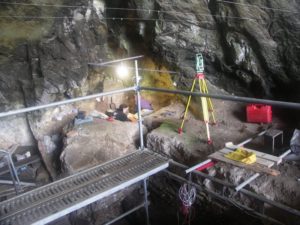 KONICA MINOLTA DIGITAL CAMERA
KONICA MINOLTA DIGITAL CAMERA The El Mirón Cave in the Cantabrian Mountains of northern Spain strikes a dramatic presence, commanding a scenic view of the lush green, mountain-framed upper valley of the Ason River far below. For the ancient human hunter-gatherers who once sojourned here tens of thousands of years ago, this was a convenient and strategic living space. From here, they could view some of their game below them, such as red deer herds migrating in the summer from the coastal plain to take advantage of the high altitude grass. The cave’s solid rock walls and high, dry vestibule would have afforded them good protection from the rigorous elements without.
Humans no longer camp here as they once did. Humanity has moved on. But a few archaeologists, students, and other scientists regularly pay their visits, and like their predecessors tens of thousands of years ago, they are also making their living by hunting and gathering—though their ‘prey’ and methods are something of a very different sort. Lawrence Straus of the University of New Mexico is one of those scientists. Along with colleague Manuel Gonzalez Morales of the Universidad de Cantabria, he has been exploring the El Mirón Cave since 1996.
“No one had ever done any work there since it was scientifically identified as a site in 1903, as archeologists believed it to be totally disturbed,” says Straus. “It was being used to stable goats. In 1995 I persuaded my old friend and colleague, Prof. Manuel Gonzalez Morales that we ought to conduct a test excavation in it, which we began in 1996.”
Since then, their findings have revealed a veritable gold mine of human occupation. El Mirón contains a long, essentially complete cultural sequence beginning with the late Middle Paleolithic through the early Bronze Age, dated using as many as 84 radiocarbon assays. Among the features and finds are rock art engravings and especially rich Magdalenian and Neolithic occupation levels. Within the Neolithic alone, according to Straus, is “the oldest evidence of wheat agriculture, domesticated animals and ceramics in northern Atlantic Spain”.
__________________________________________
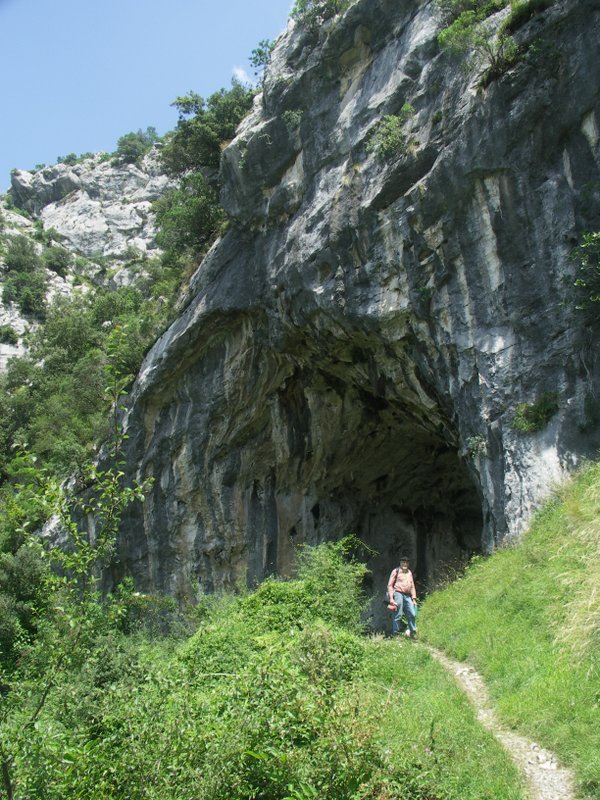 Above and below: Views of El Mirón Cave, from within and without. Excavations in the El Mirón Cave have yielded a cultural sequence of Late Mousterian, early Upper Paleolithic, Solutrean, Magdalenian, Azilian, Mesolithic, Neolithic, Chalcolithic, Bronze Age, and Medieval period occupation. The research has provided new insight on the Middle-Upper Paleolithic transition, the phases of the Magdalenian culture, the emergence of the Neolithic in the Atlantic zone of Spain, and the beginning of metal age cultural complexity. Image courtesy Lawrence G. Straus
Above and below: Views of El Mirón Cave, from within and without. Excavations in the El Mirón Cave have yielded a cultural sequence of Late Mousterian, early Upper Paleolithic, Solutrean, Magdalenian, Azilian, Mesolithic, Neolithic, Chalcolithic, Bronze Age, and Medieval period occupation. The research has provided new insight on the Middle-Upper Paleolithic transition, the phases of the Magdalenian culture, the emergence of the Neolithic in the Atlantic zone of Spain, and the beginning of metal age cultural complexity. Image courtesy Lawrence G. Straus
_________________________________________
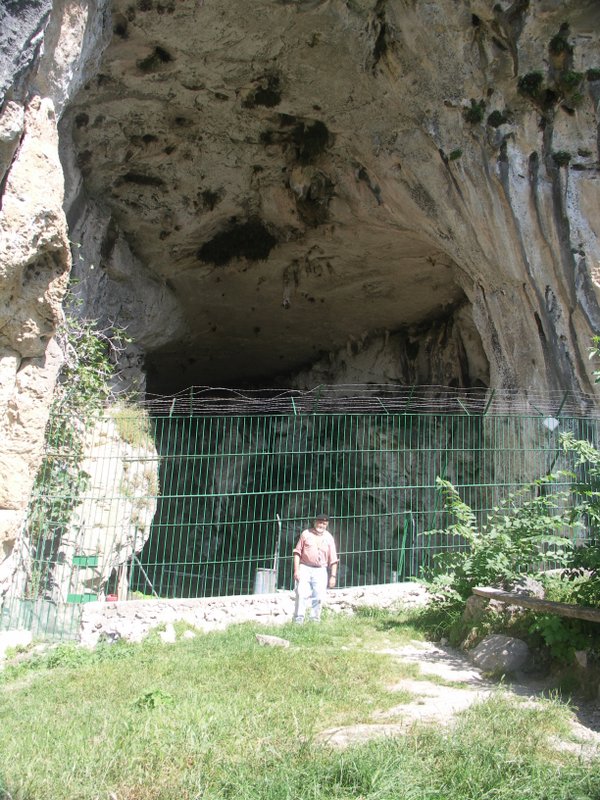 The mouth of El Mirón Cave, with L.G.Straus. Courtesy Lawrence G. Straus
The mouth of El Mirón Cave, with L.G.Straus. Courtesy Lawrence G. Straus
_______________________________________
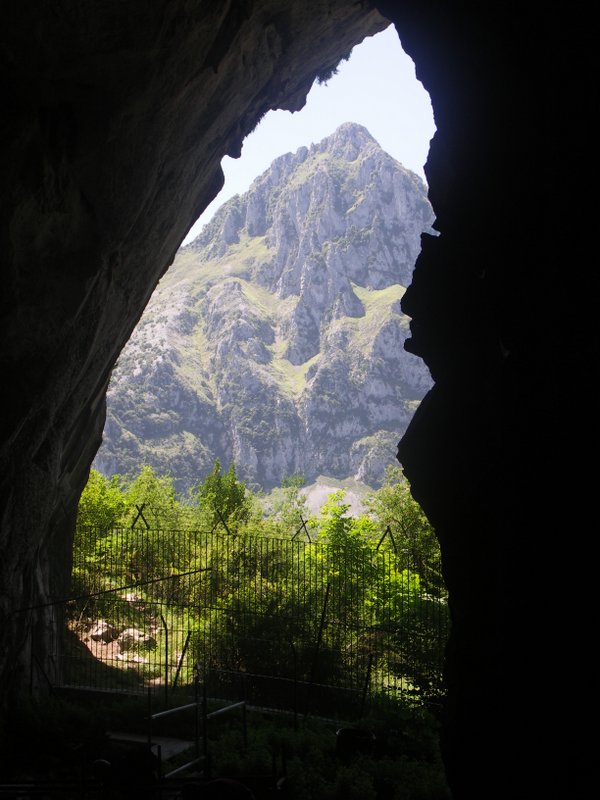 View from inside El Mirón Cave looking at Pico San Vicente in the Cantabrian Mountains (ca. 1000 m. above sea level). Courtesy Lawrence G. Straus
View from inside El Mirón Cave looking at Pico San Vicente in the Cantabrian Mountains (ca. 1000 m. above sea level). Courtesy Lawrence G. Straus
______________________________________
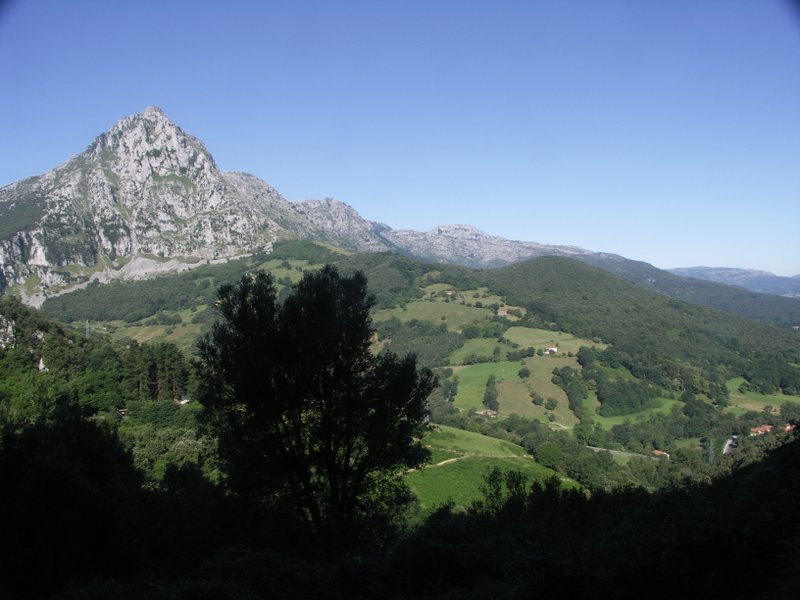 View from El Mirón Cave of Pico San Vicente and the second range of the Cantabrian Cordillera and the upper part of the Rio Ason Ruesga Valley. Courtesy Lawrence G. Straus
View from El Mirón Cave of Pico San Vicente and the second range of the Cantabrian Cordillera and the upper part of the Rio Ason Ruesga Valley. Courtesy Lawrence G. Straus
______________________________________
Straus and Morales suggest that the cave served as a seasonal camping spot for Paleolithic hunter-gatherers during the summer or warmer seasons of the year, taking advantage of the migrating game and other resources that the Cantabrian mountainous area and its river valleys afforded. This was particularly evident in the finds.
“El Mirón has one of the longest and most complete sequences for the Magdalenian in Iberia,” says Straus. Evidence from the site for this period/culture of human occupation stems from a series of C14 [radiocarbon] dates, paleoenvironmental and subsistence data, evidence for seasonally-patterned occupation and mobility and possible trade based on the presence of non-local flint, and possible stylistic or cultural differences among different groups or hunting bands based on striation-engraved red deer scapulae with red deer images possibly “linking Mirón to such coastal Lower Magdalenian sites as Altamira,” says Straus. Archaeologists were also able to determine the pattern of site use and spatial organization within the large vestibule area of the cave.
The Red Lady
From the analysis of the excavated evidence, researchers have been able to tease a picture of Lower Magdalenian culture and behavior. It depicts a people who used tools and weapons made from both local and non-local stone as well as from antlers and bones—a people who hunted ibex and chamois in the higher elevations and red deer in the Ason river valley below, where they also fished for salmon—a people who built fire pits, butchered carcasses, ate the meat and the plants they gathered, processed hides, bone marrow and grease from the animal remains, and made clothes and moccasins.
But perhaps the most tantalizing discovery came when they encountered red ochre-stained bones in a natural depression in the rear of the cave living area. They were found within a 1-meter-wide space between the cave wall and a large block of stone. They were human, dated to about 18,700 calendar years BP, deposited in a way that suggested intentional burial—an unusual find, particularly as the archaeological record thus far has suggested that the Magdalenians rarely buried their dead in the caves where they lived.
“When one is digging in the burial layer, it is not only red, but it sparkles with thousands of crystals,” said Straus. He was speaking of specular hematite crystals, which created the curious sparkle. “They specially prepared this ochre, which came from an outcrop over 20 km from the cave, despite the presence of other, local ochres in occupation layers of the cave.”
Further analysis of this burial feature and the bones revealed that the remains had been disturbed by a wolf or other canine at some point not long after initial burial, as suggested by gnaw marks on a tibia. Later, according to the analysis, the cranium and all long bones (except the tibia) had been removed, presumably by human occupants for a secondary burial or other purpose. The mandible, tibia and some other bones were re-stained with red ochre and, along with all other bones, remained in place where they had been originally buried. The bones were that of a female, about 35-40 years old, robustly built and in good health. She ate ibex, red deer, salmon and other fish, and mushrooms and other plants. “Chenopod pollen are abundant right in the center of the burial layer, perhaps because small yellow flowers were placed in the grave or because she had eaten a lot of Chenopod seeds in her last meal and they were in her stomach at death,” said Straus.
Perhaps most significant about the burial was the presence of features that suggested something more than a simple, quick interment.
Said Straus, “the burial seems to have been “marked” by engravings—a multi-line V that could represent a pubic triangle, and other signs that could possibly be hands—on a huge stone block that had fallen from the cave ceiling only a few centuries before the burial. The block fell around 19,600 cal. BP, the burial was made in the meter-wide space between the block and the vestibule rear cave wall around 18,700 cal BP, and the sloping, smooth, west-facing surface of the block was engraved more or less contemporaneously with the burial. The “rear”, east face of the block with the corpse’s back up against it was stained with red ochre to a height above the burial layer, then the block and its west-face engravings were gradually covered over by occupation layers dating to the later Lower, Middle and Upper Magdalenian and post-Upper Paleolithic periods. The engravings may well have to do with the burial and even mark it, especially if the ‘V’ was indeed a female “signifier”.” In addition, according to the published report of the findings, there were lines engraved on the bedrock lower wall and ledge against which the body had been laid behind the stone block.
Straus notes another curious feature of the ‘grave’: “Given the huge, west-facing mouth of the cave, the sunlight hits the engraved face of the block—which is located a distant 30 meters from the entrance—at the end of the afternoon.”
Was this a human grave containing a person who was perhaps revered or respected by her family or contemporaries?
The evidence appears to suggest it. Straus states that the burial findings indicate “a complex, no doubt ritualized sequence of events”, not typically found in the prehistoric deposits of human remains. As he and other study authors report in a recently published paper in the online Journal of Archaeological Science:
Although lacking in clear grave offerings, the amounts of red ochre on the bones and in the burial infilling and the apparent association with rock art (both engravings and red ochre on the block against which the corpse’s back had probably rested), the evidence points to a ritualized interment, different from, but equally impressive as such famous primary burials of Magdalenian age and cultural affiliation on the territory of France as Duruthy, Saint-Germain-la-Riviere, La Madeleine, Laugerie- Basse, Bruniquel, or Chancelade*
In any case, within the context of other finds at El Mirón, the ‘Red Lady’, as the red-ochre-stained burial subject has been aptly named, helps to paint a picture of a people who managed a living more than 18,000 years ago as hunter-gatherers in the cold, open environment of the Ice Age Oldest Dryas (much like an Alpine valley of today), and who likely regarded and related to each other in much the same way as we do today. In and around the cave, “they ate, sang, danced, told stories, reproduced, laughed, cried, slept … and they died.”*
And then there was this one, special burial.
Straus and colleagues would be the first to say that they will never know the full truth of what was happening in this space, but the available archaeological evidence, including lines in stone, could give clues for reasonable hypotheses.
_________________________________________
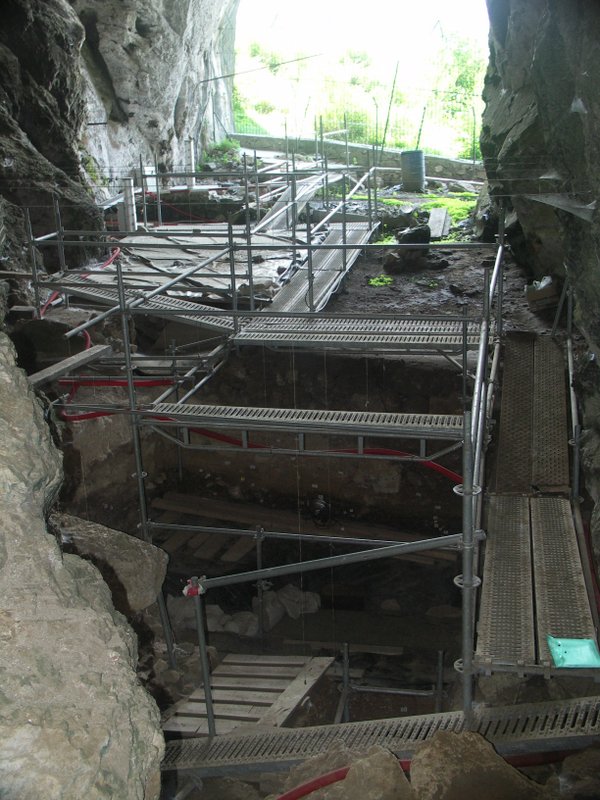 Inside the cave: The cave vestibule with excavation areas. Burial is out of the photo at center left behind block. Courtesy Lawrence G. Straus
Inside the cave: The cave vestibule with excavation areas. Burial is out of the photo at center left behind block. Courtesy Lawrence G. Straus
_____________________________________________________
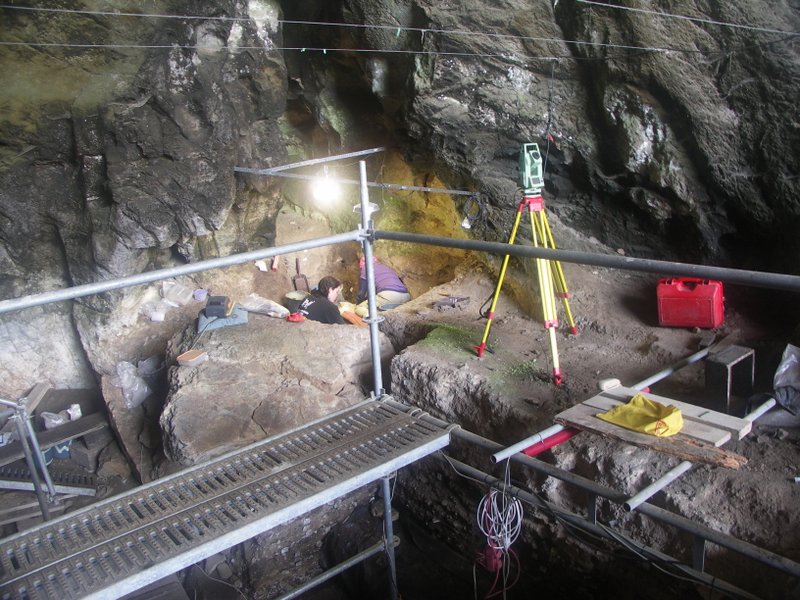 Inside the cave: Excavation in the burial area behind the engraved block. Courtesy Lawrence G. Straus
Inside the cave: Excavation in the burial area behind the engraved block. Courtesy Lawrence G. Straus
_____________________________________________________
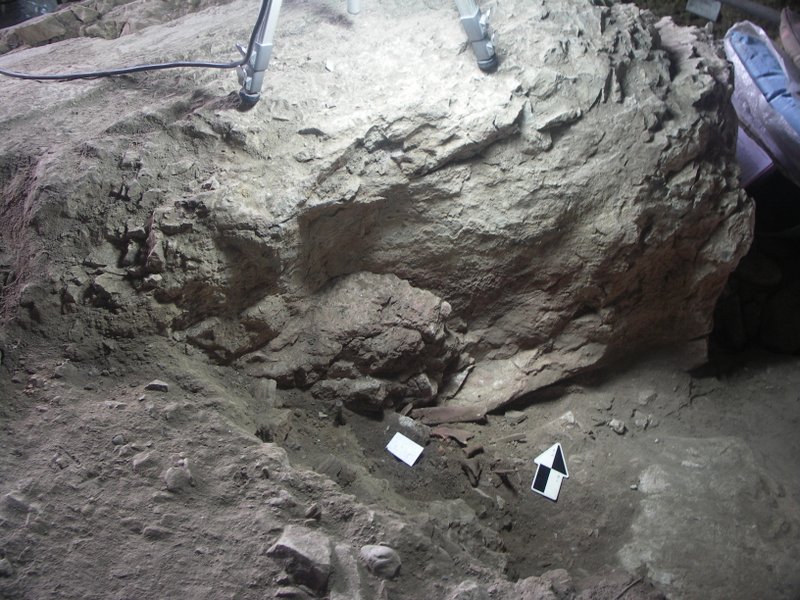 The Red Lady burial, with mandible, clavicle, gnawed tibia, red ochre-stained sediment and east face of block. Courtesy Lawrence G. Straus
The Red Lady burial, with mandible, clavicle, gnawed tibia, red ochre-stained sediment and east face of block. Courtesy Lawrence G. Straus
_____________________________________________________
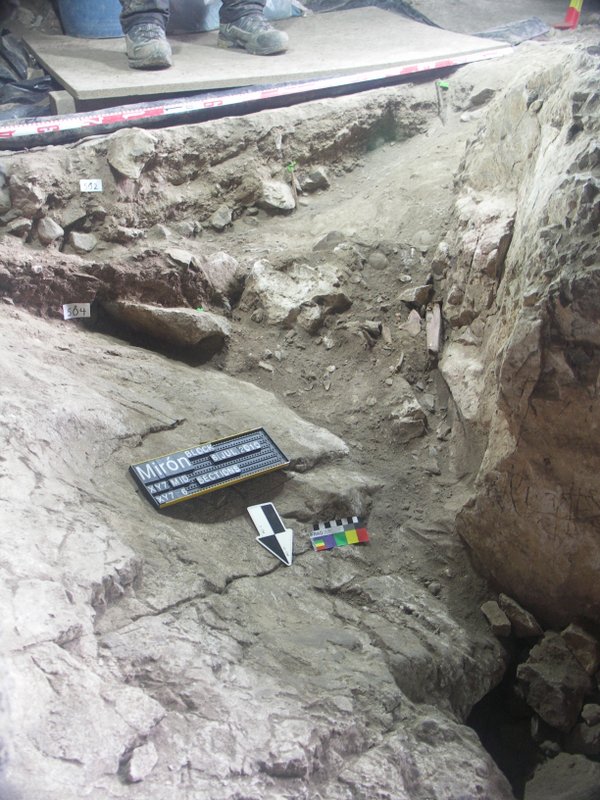 The Red Lady burial, with mandible, tibia, red-stained sediment and east face of block, rocks atop more skeletal remains. Courtesy Lawrence G. Straus
The Red Lady burial, with mandible, tibia, red-stained sediment and east face of block, rocks atop more skeletal remains. Courtesy Lawrence G. Straus
_______________________________________________________
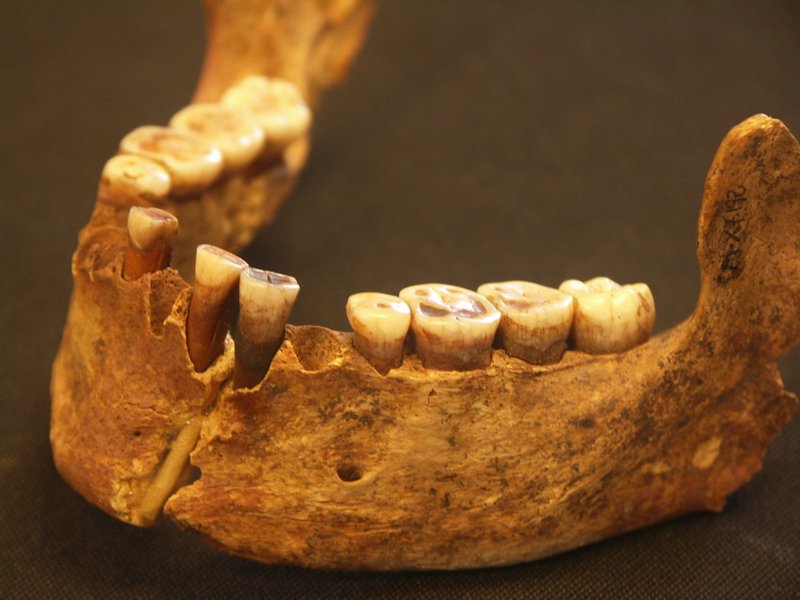 The Red Lady mandible. Courtesy Lawrence G. Straus
The Red Lady mandible. Courtesy Lawrence G. Straus
___________________________________________________
Looking Ahead
Straus stresses that there is much more to do before additional conclusions can be drawn about El Mirón and its place in understanding the ancient Lower Magdalenian culture. Research will revolve around questions concerning the lithic technology, faunas, human settlement subsistence systems, mobility, trade, site occupation functions, seasonality, palynology, and further study of site features such as pits, walls and hearths, including the red ochre found on the east face of the stone block. But “most importantly,” said Straus, “we want to see completion of the DNA analyses by Dr. Svante Paabo’s team on the Red Lady to determine the genetic role of human populations that had survived the Last Glacial Maximum in southern France and Iberia in the subsequent (Magdalenian-age) resettlement of northern and Northwest Europe.”
Thus, El Miron stands to play a critical role in advancing what we know about the Lower Magdalenian culture and its environmental context. But some tantalizing questions will likely never have answers.
“At the end of the day, we are left with a mystery,” concludes Straus. “Who was the “Red Lady” of El Miron and why was she given such special treatment after her death?”
________________________________________
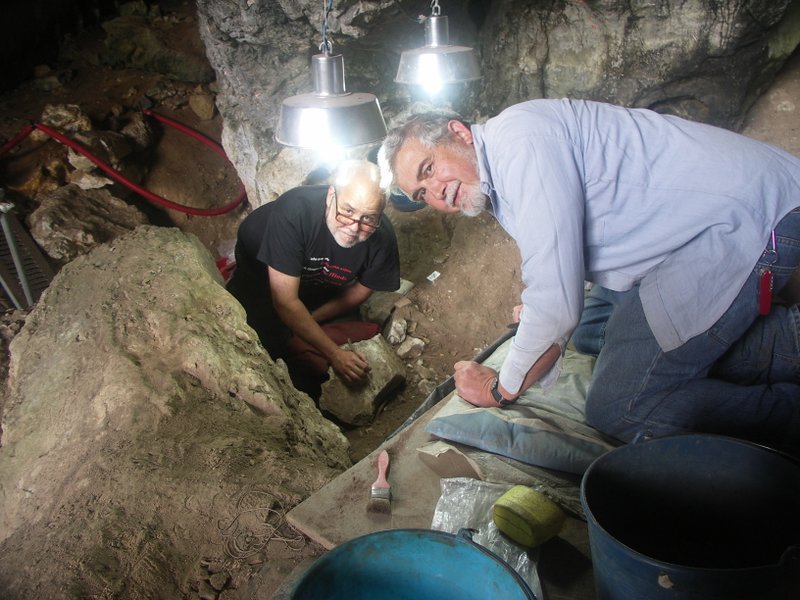 Profs. Manuel Gonzalez Morales (Universidad de Cantabria) and Lawrence Straus (Univ. of New Mexico) excavating the El Mirón Cave Red Lady Magdalenian burial. Courtesy Lawrence G. Straus
Profs. Manuel Gonzalez Morales (Universidad de Cantabria) and Lawrence Straus (Univ. of New Mexico) excavating the El Mirón Cave Red Lady Magdalenian burial. Courtesy Lawrence G. Straus
________________________________________
Co-directing this research is Professor Manuel Gonzalez Morales (Universidad de Cantabria in Santander), with the osteological study of the Red Lady skeleton organized and spearheaded by Prof. Jose Miguel Carretero (Universidad de Burgos, a member of the Atapuerca research team). Funding has been provided by the National Science Foundation (NSF), National Geographic Society, LSB Leakey Foundation, the Regional Government of Cantabria, the Spanish Ministry of Science and Education, the Marcelino Botin Foundation, the University of New Mexico and the UNM Fund for Stone Age Research.
The detailed study is published as a special issue of the Journal of Archaeological Science (guest edited by L.G.Straus, M.R. Gonzalez Morales and J.M. Carretero): “The Red Lady of El Miron Cave: Lower Magdalenian Human Burial in Cantabrian Spain”. The issue features 13 articles, all of which are now available on-line and released in a hard -copy version during the summer of 2015.
_________________________________________
*Straus, L.G., et al., “The Red Lady of El Miron”. Lower Magdalenian life and death in Oldest Dryas Cantabrian Spain: an overview, Journal of Archaeological Science (2015), http://dx.doi.org/10.1016/j.jas.2015.02.034




